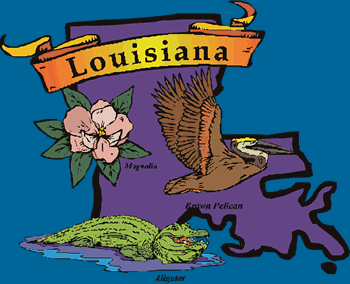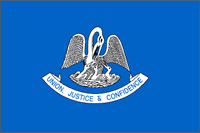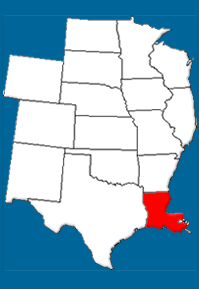 History:
Although Louisiana has at one time or another been under the flags of Spain, France, Britain, the United States, and even its own territorial flag, no one knows for sure which European explorer first set foot in Louisiana. In 1519, Alonso Alvarez de Pineda explored the northern shore of the Gulf of Mexico and may have been the first to discover the mouth of the Mississippi River. By 1542, Hernando de Soto was also exploring the area of the Mississippi. However, it was not until 1682 that Sieur de La Salle "took possession" of the area on behalf of the country of France and named it Louisiana in honor of France's King Louis XIV. The first permanent settlement in Louisiana was established in 1714 by Louis Juchereau de St. Denis, and was called Fort St. Jean Baptiste. Today, the settlement is present-day Natchitoches.
Unfortunately, these early settlers were unsuited to life on the frontier and their colony did not prosper. By 1717, the government of France had granted all colonization rights to a Scotsman named John Law who had devised a plan to increase commerce in the area. Using the names "Company of the West" and "Company of the Indies," Law tried to entice settlement by promising colonists they would become wealthy through the minerals which they could find in the area. These projects were terrible failures, and the government of France lost a significant amount of money. However, the publicity gained from even these failed attempts did lead to further settlement.
Louisiana became a French crown colony in 1731 with the collapse of Law's settlement companies. By 1762, however, the French realized that the colony was continuing to lose money, and the area was ceded (given) to Spain after the French and Indian War. The British gained control of Florida, which then bordered the colony. Control of the area went back and forth between the Spanish and the British. Meanwhile, French Acadians, who had been driven out of Nova Scotia by the British, began migrating to Louisiana. The Spanish attempted to offset the growing French population in Louisiana, but by 1800, they returned the colony to the French through the Treaty of San Ildefonso. Three short years later, in 1803, Napolean sold Louisiana to the United States as part of the Louisiana Purchase.
Despite the fact that Louisiana was under the control of several European nations early in its history, African natives made up a large proportion of the population in the 18th and 19th century. The rich blend of cultures in the area, including native American Indian, African and European, meant that no one lifestyle, religion or culture dominated in early Louisiana history.
The Louisiana Purchase doubled the size of the United States, and it put the new country in a position to become a world power. The Purchase represented over 900,000 square miles, and these lands eventually became all or part of thirteen states: Louisiana, Arkansas, Missouri, Iowa, North Dakota, South Dakota, Nebraska, Kansas, Wyoming, Minnesota, Oklahoma, Colorado and Montana.
In 1812, Louisiana became the 18th state to join the Union and encompassed what had been the Territory of New Orleans. For the time being, the rest became the Missouri Territory. Not until 1819, however, were the so-called Florida Parishes and the lands west of the Red River added to form the present state boundaries.
During the War of 1812, the British moved ships up the Mississippi River to New Orleans, but in 1815, Andrew Jackson defeated them in the Battle of New Orleans. The battle, actually fought 15 days after the Treaty of Ghent (which ended the war) was signed, ending the war, was decisive in preventing the territory from being returned to the British once again.
By 1860, the population of Louisiana was over 700,000 and the plantation system, fueled by slave labor, dominated the state's economy. In 1861, Louisiana seceded from the Union, and for several months, until joining the Confederacy, existed under independent territorial rule.
More than 500 battles, engagements and skirmishes were fought in Louisiana during the Civil War. New Orleans represented the South's largest city and was a major port city, so it was a primary target during the war. Approximately 20% of the state's able-bodied white young men were killed in battle or died of disease. Hundreds of black soldiers were killed as well.
1877 President Rutherford B. Hayes finally withdrew US army troops from Louisiana after the longest occupation of any of the southern states during Reconstruction.
In 2005, Hurricanes Katrina and Rita devastated much of the Louisiana coastline, destroying entire communities and much of the city of New Orleans. Rebuilding has been slow, and is far from complete. |









